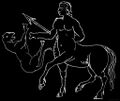Centaurus: Difference between revisions
No edit summary |
|||
| Line 10: | Line 10: | ||
===Transfer and Transformation of the Constellation=== |
===Transfer and Transformation of the Constellation=== |
||
<gallery> |
<gallery> |
||
File:Stellarium-UR.IDIM.jpg|Jessica Gullberg's impression of the Babylonian constellation UR.IDIM (The Mad Dog) in Stellarium 2021. |
|||
File:Cen+lup kugel.jpg|Centaurus et Lupus on the ancient Greek Kugel Globe, drawing by SMH 2021. |
File:Cen+lup kugel.jpg|Centaurus et Lupus on the ancient Greek Kugel Globe, drawing by SMH 2021. |
||
File:FarneseSMH2017 web 11.jpg|Centaurus et Lupus on the ancient Greco-Roman Farnese Globe, drawing by SMH 2017. |
File:FarneseSMH2017 web 11.jpg|Centaurus et Lupus on the ancient Greco-Roman Farnese Globe, drawing by SMH 2017. |
||
Revision as of 11:10, 23 August 2024
One of the 88 IAU constellations. The ancient Greek constellation of the Centaur forms a super-constellation with Lupus and Ara. It is unknown whether or not Centaurus had a Babylonian predecessor: The Mesopotamian uranologies in this area mention a god (Numushda) whose appearance and exact location in the sky are not preserved, and the constellation UR.IDIM which is commonly translated as "Mad Dog" (or rabid dog) but also associated with a benevolent door keeper daemon who is a lion-man. Such a lion-man may possibly be depicted in seal imprints and mythologically named Urmahlullu.
Etymology and History
The Greek constellation is possibly derived from a Babylonian one. There were several centaur-like creatures and other mixed man-animal beings in Mesopotamian culture; seal imprints and reliefs witness them.










